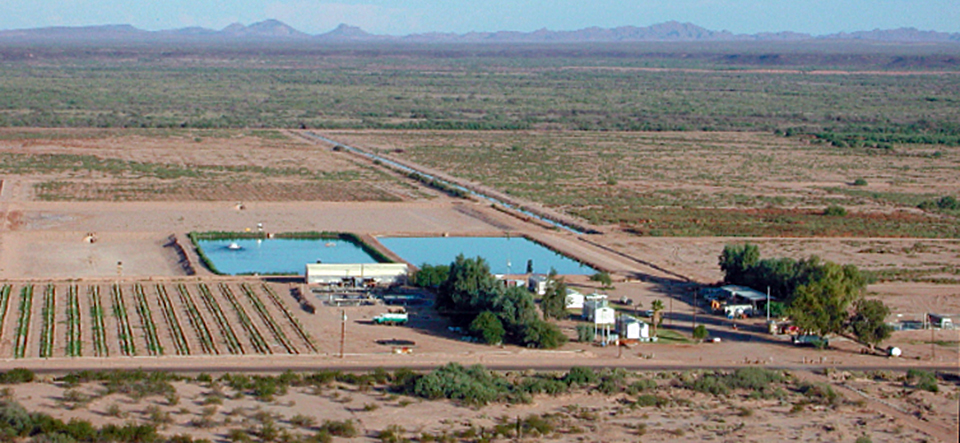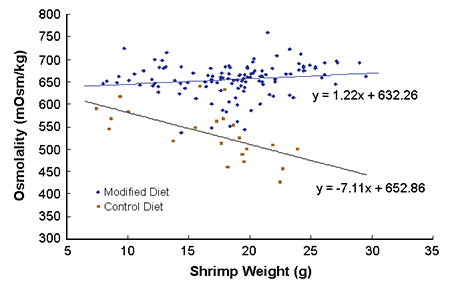Study examines shrimp osmoregulatory capacity

Since the first pioneer shrimp farm was established in the area in 1997, shrimp farming in Arizona, USA, has expanded rapidly. The low cost of land, abundant resources of underground saline well water, diseasefree environment, and potential for integrated aquaculture-agriculture farming have facilitated the development. There are now four farms in the Sonora Desert along the Gila River.
Osmoregulatory capability
As a euryhaline warmwater species, Litopenaeus vannamei currently is the only species cultured in Arizona because of its adaptability to low salinity and high temperatures, especially during the late postlarval and juvenile stages. However, the osmoregulatory capability of this species declines naturally when the animals reach subadult or adult stages.
The salinity of well water used for shrimp farming in the region ranges 1.5 to 8 ppt. The ion compositions of the saline water are typically low in magnesium and potassium compared with diluted seawater at the same salinity (Table 1). Consequently, a variety of disease conditions including cramp muscle syndrome and low lipids in midgut glands have been noted in shrimp farmed in Arizona.
Gong, Comparison of ion compositions, Table 1
| Average Groundwater | Average Groundwater | Average Groundwater | Average Groundwater | Average Groundwater | Diluted Seawater | Diluted Seawater | Diluted Seawater | Diluted Seawater | Diluted Seawater |
|---|
Average Groundwater | Average Groundwater | Average Groundwater | Average Groundwater | Average Groundwater | Diluted Seawater | Diluted Seawater | Diluted Seawater | Diluted Seawater | Diluted Seawater | |
|---|---|---|---|---|---|---|---|---|---|---|
| Salinity (ppt) | 0.7 | 1.7 | 3.0 | 5.0 | 8.0 | 0.7 | 1.7 | 3.0 | 5.0 | 8.0 |
| Ca (ppm) | 29 | 113 | 300 | 448 | 500 | 8 | 20 | 35 | 59 | 94 |
| Mg (ppm) | 2 | 8 | 33 | 72 | 257 | 28 | 68 | 119 | 199 | 318 |
| Na (ppm) | 250 | 574 | 910 | 1,556 | 2,496 | 216 | 525 | 926 | 1,544 | 2,471 |
| K (ppm) | 4 | 8 | 11 | 10 | 21 | 8 | 19 | 34 | 56 | 88 |
| Cl (ppm) | 295 | 289 | 1,143 | 2,000 | 3,690 | 391 | 950 | 1,676 | 2,794 | 4,471 |
| SO42--S (ppm) | 43 | 180 | 320 | 572 | 749 | 56 | 135 | 238 | 397 | 635 |
| Ratio: | ||||||||||
| Mg/Ca | 1:5 | 1:5 | 1:5 | 1:5 | 1:5 | 3.4:1 | 3.4:1 | 3.4:1 | 3.4:1 | 3.4:1 |
| Na/K | 97.1 | 97.1 | 97.1 | 97.1 | 97.1 | 28:1 | 28:1 | 28:1 | 28:1 | 28:1 |
Furthermore, serious mass mortality episodes associated with molting often occur when shrimp reach 18 to 20 grams, especially in the hot summer, when water temperatures reach their seasonal peaks of up to 35 degrees-C. It has been a great challenge for farmers to raise larger shrimp to increase profitability under such conditions.
To avoid losses, a common strategy was to harvest the shrimp as they reached the critical size and before heavy mortality began to occur with molting. The authors attempted to address this problem by improving osmoregulatory capacity through dietary modifications.
Dietary modifications
A modified diet supplemented with magnesium, potassium, phospholipids, and cholesterol was formulated specifically for Arizona inland shrimp farming. The control diet was a commonly used commercial shrimp feed (Table 2). The modified diet was applied at Arizona Mariculture Associates (AMA), while the control diet was used at the nearby Desert Sweet Shrimp Farm (DSSF) throughout the 2001 culture season.
Gong, Comparison of modified and control diet compositions, Table 2
| Ingredient | Modified Diet (%) | Control Diet (%) |
|---|
Ingredient | Modified Diet (%) | Control Diet (%) |
|---|---|---|
| Moisture | 10 | 10 |
| Protein | 40 | 45 |
| Squid meal | 5 | 10 |
| Lipid | 9.5 | 8 |
| Fiber | < 4 | < 4 |
| Ash | < 15 | < 15 |
| Other Ingredients | ||
| Deoiled lecithin | 1.5 | – |
| Cholesterol | 0.1 | – |
| MgO | 0.8 | – |
| NaCl | 0.5 | – |
| KCl | 0.5 | – |
The dietary modifications directly aimed to compensate the ion deficiencies in the well water. Another aspect was to provide additional essential lipids, which are related to lipid metabolism and may be more critical for shrimp raised under low salinity and high temperature.
Magnesium
Magnesium is an important component of many enzymes. In the Arizona groundwater resources used for shrimp farming, the magnesium concentration of well water is only about 30 percent of that in diluted seawater at the same salinity. More importantly, its beneficial effect on reducing the cramped muscle syndrome in shrimp was evident from the experimental practice at AMA.
Potassium
Because the water at Arizona Mariculture Associates was extremely low in potassium (10 milligrams per liter), dietary supplementation of potassium was deemed necessary, not only to supply the internal potassium pool, but also to facilitate the normal functions of other ions, such as sodium.
Phospholipids and cholesterol
Maintaining constant body fluid concentrations against an osmotic gradient obviously requires the expenditure of energy. Shrimp growth rates obtained in this region were apparently much higher than those reported for farms in other states in the United States, which is presumably due to higher water temperatures. High temperature accelerates shrimp metabolic rates and increases molting frequency. Sufficient lipid storage in the hepatopancreas is critical for shrimp going through the frequent molts.
Cholesterol is an essential lipid that is closely involved in the molting process of shrimp. Dietary phospholipids are nutritionally superior to neutral lipids because of their function as structural molecules. They are sources of phosphorus and essential fatty acids, as well as a source of energy. In addition to facilitating cholesterol transport, dietary inclusion of phospholipids could significantly increase the total lipid content in the hepatopancreas of L. vannamei, as found in recent studies.
Osmolality capacity
Hemolymph sampling
Earthen pond-reared L. vannamei of 7 to 30 grams at intermolt stages C-D0 were sampled continuously at the test farms to determine hemolymph osmolality. In general, shrimp were sampled before the first feeding in the morning, held in an aerated container, and gradually cooled to 17 degrees-C during a three hour period prior to sampling. Shrimp hemolymph was drawn from the ventro- lateral sinus in the first abdominal segment using 1-ml syringes and transferred into 1.7-ml centrifuge tubes.
Each hemolymph sample was centrifuged immediately for 15 minutes at 4 degrees-C. The supernatant was transferred to other tubes and osmolality measured using a vapor pressure osmometer at the Aquaculture Pathology Lab at the University of Arizona in Tucson.
Dietary effects on osmolality

Results showed the modified diet not only changed the trend of hemolymph osmolality in response of size, but also improved osmoregulatory capacity. As the shrimp grew, the hemolymph osmolality of shrimp at Desert Sweet Shrimp Farm gradually diminished (y = -7.11x + 652.86), while that of shrimp at Arizona Mariculture Associates maintained a higher level and even showed a slight increasing trend with shrimp size increase (y = 1.22x + 632.26) (Fig. 1).
The hyperosmoregulatory capacity of shrimp from Arizona Mariculture Associates (462 milliosmoles per kilogram) was greater than that from Desert Sweet (398 milliosmoles per kilogram), with no molting effect detected in the former. The results showed that shrimp reared at Arizona Mariculture Associates had better osmoregulatory capacity and more stable osmolality, which indicated they were better osmoregulators.
The effect of stressors on osmoregulation is usually detectable at sublethal levels, often before mortality is noted among exposed animals. Results from the study also showed the modified diet contributed to maintaining shrimp osmoregulatory capacity at a stable higher level, even after shrimp reached 25 grams, which resulted in survival rates up to 84 percent in some ponds.
As mentioned above, shrimp metabolic rate and molting frequency increase as a result of high water temperature. Therefore, more stable osmoregulatory capacity is essential for shrimp to deal with the adverse effects of frequent molting in low-salinity water at elevated temperatures.
Conclusion
Previously, it was believed that 18- to 20-gram shrimp were the optimal size for harvesting in Arizona. The present study demonstrated that the osmoregulatory capacity of shrimp can be improved through dietary modification. Production results from the 2001 and 2002 culture seasons showed it was commercially feasible to raise shrimp larger than 25 g on the modified diet. Adult L. vannamei (55-gram females and 45-gram males) have been raised under continuous low-salinity conditions with the same diet.
This study was a first step toward optimizing dietary formulations specific to shrimp farming in Arizona. More research should investigate the physiological functions of the Mg, K, and Na cations in shrimp osmoregulation, and quantify dietary requirements for magnesium, potassium, and other minerals in the shrimp cultured in Arizona groundwater.
(Editor’s Note: This article was originally published in the August 2003 print edition of the Global Aquaculture Advocate.)
Now that you've finished reading the article ...
… we hope you’ll consider supporting our mission to document the evolution of the global aquaculture industry and share our vast network of contributors’ expansive knowledge every week.
By becoming a Global Seafood Alliance member, you’re ensuring that all of the pre-competitive work we do through member benefits, resources and events can continue. Individual membership costs just $50 a year. GSA individual and corporate members receive complimentary access to a series of GOAL virtual events beginning in April. Join now.
Not a GSA member? Join us.
Authors
-
-
Dong-Huo Jiang, Ph.D.
Sygen International
Berkeley, California, USA -

Donald V. Lightner, Ph.D.
University of Arizona
Tucson, Arizona, USA -
Craig Collins
Desert Sweet Shrimp Farm,
Gila Bend, Arizona, USA
Related Posts

Intelligence
Considerations for tilapia farming in saltwater environments
Tilapias are farmed in a variety of production systems, but mostly in freshwater and low-salinity waters. But tilapias are an excellent candidate for aquaculture in brackish- and seawater because they can tolerate a wide range of water salinity.

Responsibility
Farming algal fuel: Economics challenge process potential
Algae offer advantages over terrestrial plants for biofuel production: short generation cycles and fast population growth. Algal fuel production would spare corn and soybeans for consumption as food for humans.

Responsibility
Growth away from the coast: Examining inland shrimp farming
Inland shrimp culture has numerous advantages – improved biosecurity, lower cost of land and reduced conflicts with other users of common resources like land and water – and will continue to expand into new areas.

Aquafeeds
Sunlight, seawater and wind: A simple recipe for ambitious algae grower Susewi
Utilizing proven large-scale pond engineering, Susewi aims to become the world’s largest producer of algal biomass, with its sights set on aquafeeds.


